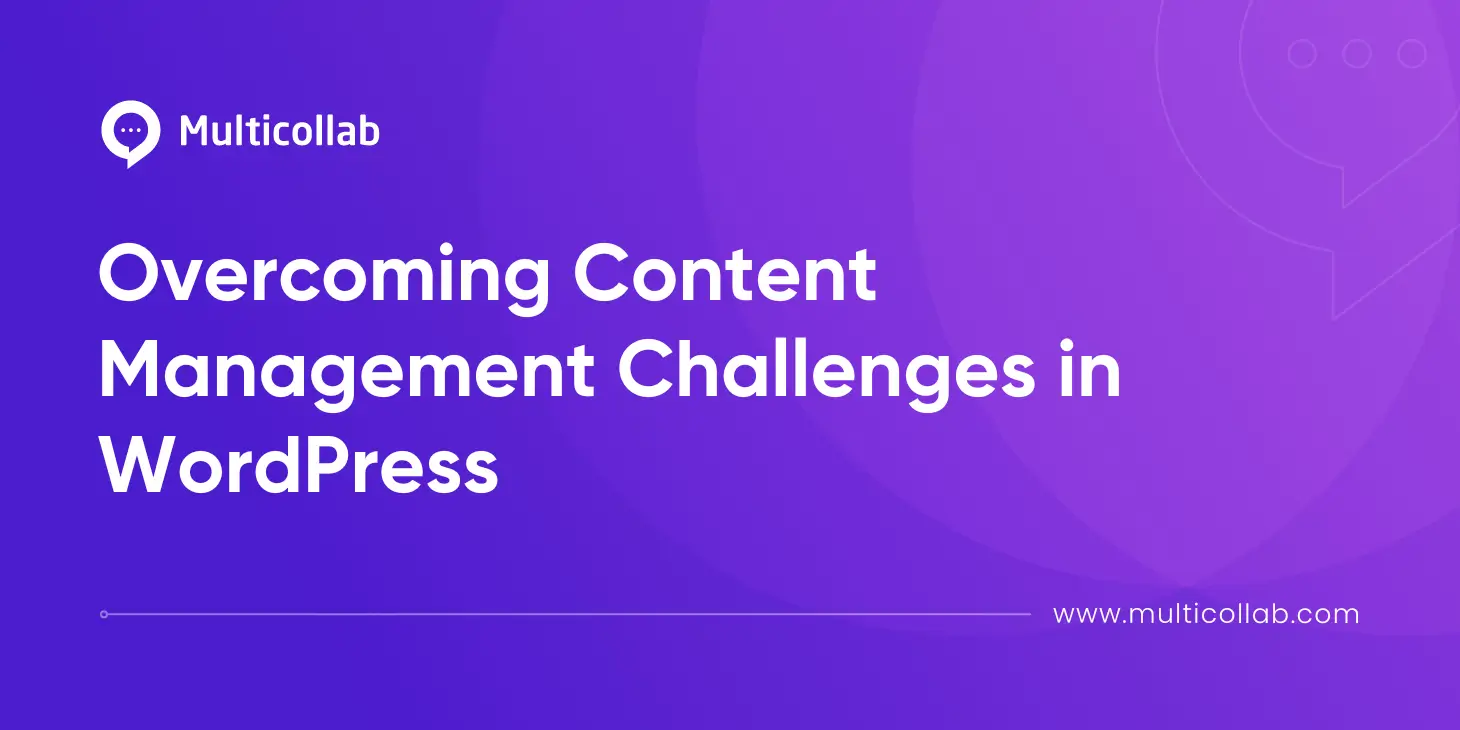Table of Contents
WordPress, while a powerful platform for content creation, presents its users with numerous challenges in managing content effectively.
From drafting content to navigating approval processes, WordPress content and editorial teams face a variety of challenges that can hinder their productivity and efficiency. In this article, we’ll explore these pain points and provide actionable strategies to help WordPress teams overcome them and succeed in their content management.
Identifying WordPress Content Management Pain Points
1. Inefficient Drafting Processes
Drafting content within WordPress often becomes a frustrating process due to several factors. Version control issues arise when multiple team members collaborate on a single piece of content, leading to confusion about the most current version.
Scattered feedback compounds the problem, with comments and suggestions dispersed across various communication channels, making it challenging to consolidate and implement revisions.
Collaboration hurdles further hinder the drafting process, as coordinating input from team members becomes cumbersome and time-consuming.
Utilizing tools like Google Docs or dedicated WordPress plugins for collaborative drafting like Multicollab offers a centralized platform for content creation. These tools allow team members to work simultaneously on a document, track changes, and provide feedback in real-time.
2. Content Organization and Navigation
Managing a growing volume of content in WordPress can be challenging without a clear organizational structure.
Implementing a robust navigation system, including a taxonomy for content categorization and intuitive menus, improves content discoverability and enhances user experience. By optimizing search functionality, WordPress teams can transform their digital repository into a well-organized resource, boosting productivity and user satisfaction.”
3. Approval Bottlenecks
The journey from draft to publish often encounters significant roadblocks in the form of approval bottlenecks. Content must pass through multiple layers of review and approval before it can be published, causing delays and frustration among team members.
Without a streamlined approval process, content can languish in limbo, missing deadlines and losing relevance.
To overcome this challenge, content teams must establish clear approval workflows tailored to their organization’s needs. This involves defining roles and responsibilities, setting deadlines, and implementing transparent communication channels.
Tools like Slack or Trello can facilitate communication and collaboration, enabling team members to track the progress of content through the approval process and address any issues or concerns promptly.
Strategies for Streamlining Content Management
Efficient content management enables organizations to deliver engaging, relevant, and timely content to their audience. However, the process can often be complex and time-consuming, leading to inefficiencies and bottlenecks. Hence, organizations must adopt strategies to streamline their content management processes, allowing them to produce high-quality content more effectively and efficiently.
1. Utilizing Editorial Calendar Plugins
Effective content management is based on meticulous planning and organization. The editorial calendar serves as the guiding compass through this entire process. Editorial calendar plugins emerge as indispensable assets, offering a centralized platform for scheduling, organizing, and managing content seamlessly.
Plugins like Editorial Calendar or CoSchedule provide content teams with a robust framework to visualize their content roadmap, track deadlines, and facilitate seamless collaboration—all within the familiar confines of the WordPress dashboard. By harnessing the capabilities of these tools, content teams can chart a definitive course towards success, ensuring every piece of content finds its rightful place within the digital ecosystem.
2. Implementing Workflow Automation Tools
Workflow automation tools are essential for optimizing productivity in digital publishing. Platforms like Zapier or Integromat allow content teams to automate a variety of tasks, from content distribution to social media promotion, with minimal effort. By streamlining workflows and reducing manual interventions, these tools ensure content reaches its audience faster and more efficiently, freeing up valuable time for content creators to focus on crafting exceptional content.
3. Establishing Clear Approval Workflows
Without clear guidelines and defined processes, chaos reigns supreme, and productivity suffers. Approval workflows serve as the backbone of content governance, providing a structured framework for content review and sign-off.
To establish an effective approval workflow, tools like Multicollab can help content teams identify key stakeholders and their respective roles in the approval process. From there, they can define clear criteria for review, set realistic deadlines, and leverage seamless collaboration and feedback. By standardizing the approval process, teams can ensure content moves swiftly through the pipeline, minimizing delays and maximizing efficiency.
4. Leveraging Team Collaboration Tools
Platforms like Slack or Microsoft Teams empower teams to collaborate in real-time, regardless of geographical barriers. By fostering a culture of transparency and collaboration, these tools break down silos, encourage knowledge sharing, and propel teams towards their shared goals with unparalleled efficiency.
Multicollab is a transformative plugin which has been designed to streamline collaboration for content approval within WordPress so that content teams can overcome collaboration challenges. Key features of Multicollab include:
Real-time Editing and Commenting within WordPress: Users can collaborate with multiple users simultaneously and edit content together in real-time. Hence, content teams can work more efficiently, make instant changes, and witness content come to life collaboratively – right in the WordPress interface. This centralized communication improves efficiency, shortens feedback loops, and eliminates organizational silos and bottlenecks.
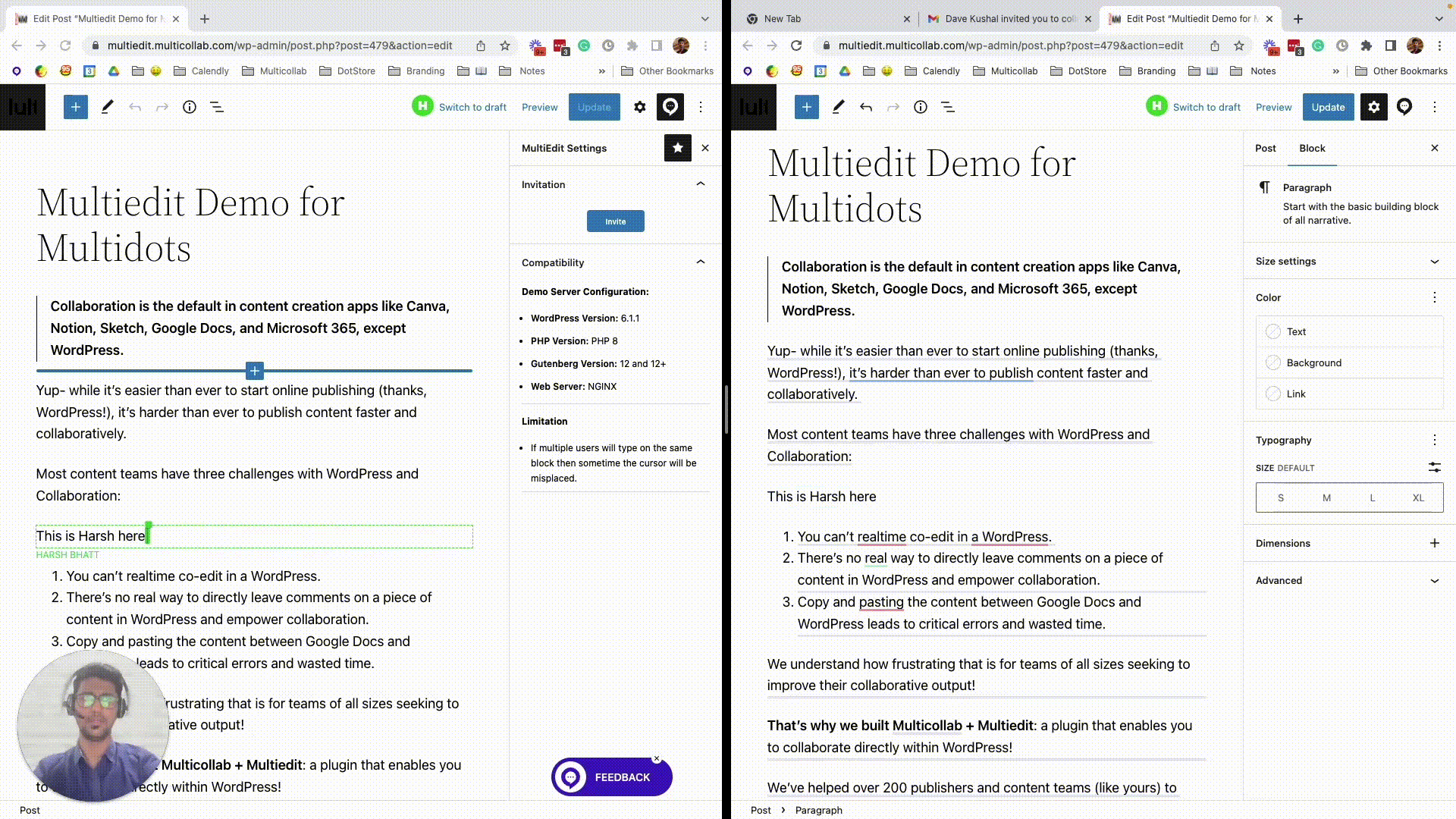
Automatic Slack and Email Notifications: With enabled email notifications, teams can quickly review and easily click notifications to respond directly in WordPress. Team members receive instant alerts when tasks are assigned to them, enhancing accountability and clarity in roles and responsibilities.
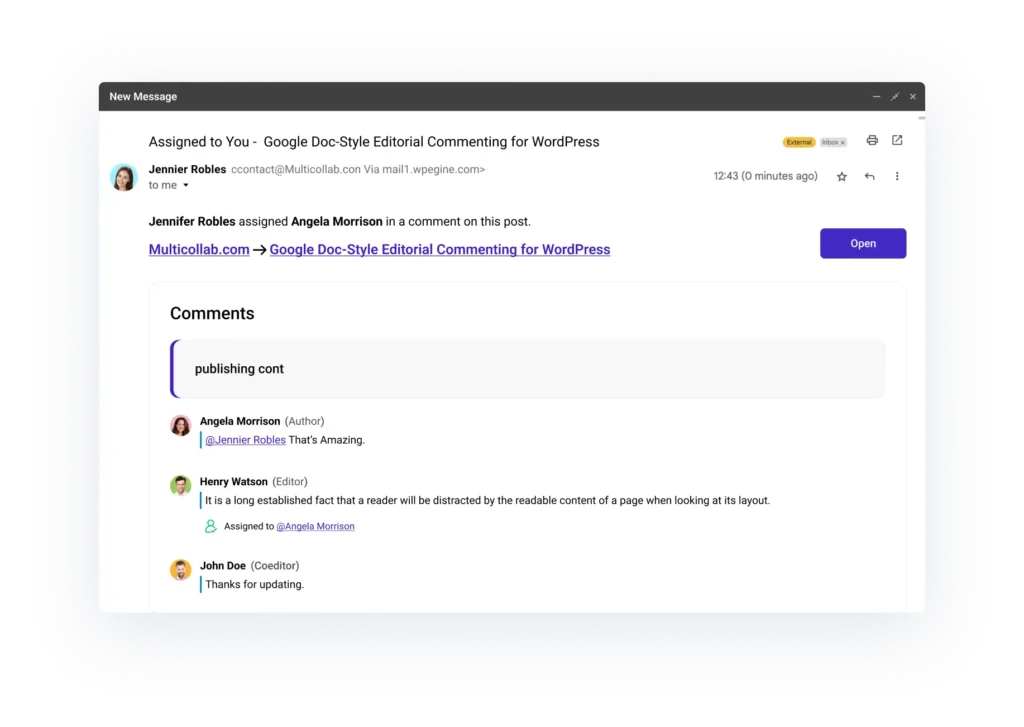
Activity Timelines and Snapshot Reporting: With the Advanced Dashboard functionality, teams can get better insight into their editorial workflow with transparent data points and an intuitive reporting feature. The Activity Timeline monitors collaboration and tracks progress across all pages and posts with easy filtering to view by user, content categories, and time stamps. Teams can discover what they need with Quick Snapshot Reporting for the latest comment activities on each page and post.
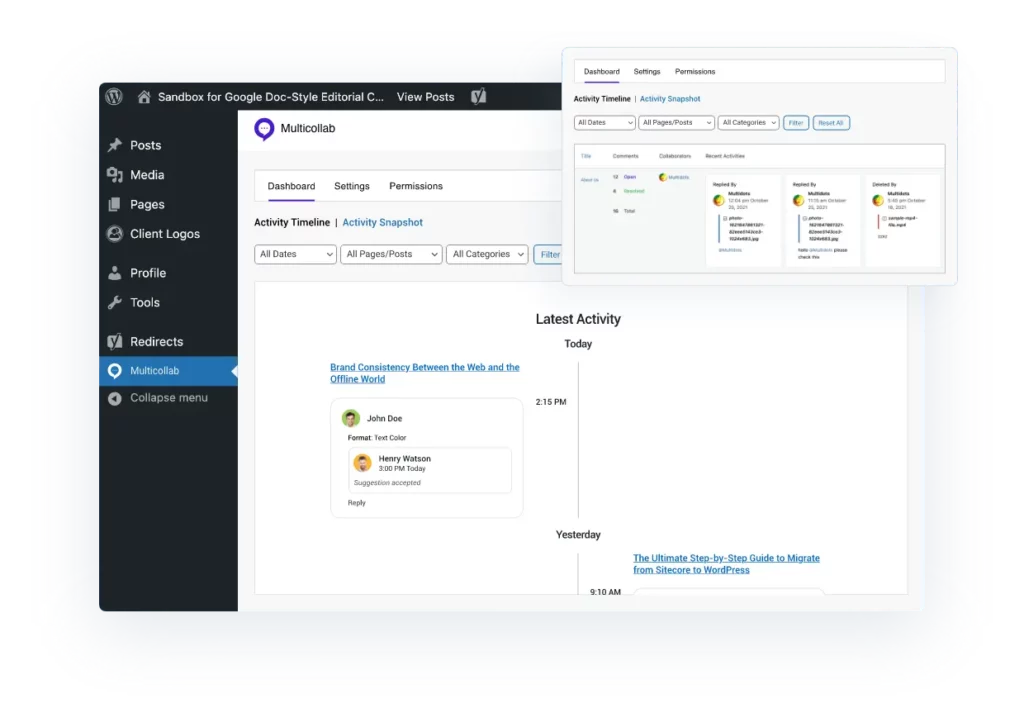
Easy Permissions Management for Collaborators: Multicollab allows assigning specific access permissions to chosen team members. For example, teams can easily decide which team members should have permission to manage comments and suggestions in Multicollab. They can configure who should have access to add a comment, resolve comments, and disable comments and who should have access to accept or reject suggestions.
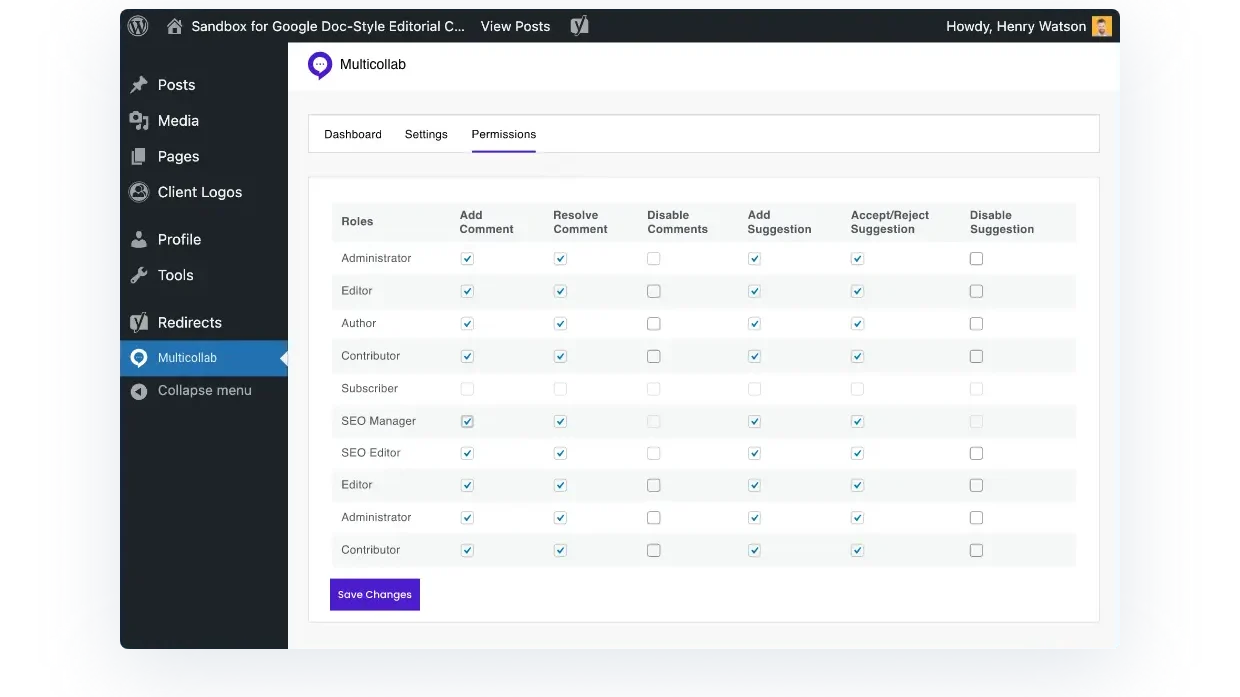
With Multicollab, teams can overcome collaboration challenges and maximize productivity, leading to smoother workflows, faster project completion, and superior outcomes. Say goodbye to collaboration roadblocks and hello to seamless teamwork with Multicollab.
5. Improving Communication Channels
Miscommunication and misunderstandings can derail even the best-laid plans. To foster clear and concise communication, content teams must leverage a combination of synchronous and asynchronous channels tailored to their needs.
Synchronous channels like instant messaging or video conferencing facilitate real-time communication, enabling teams to address urgent issues and brainstorm ideas on the fly. Asynchronous channels like email or project management tools provide a platform for more structured communication, allowing teams to collaborate at their own pace without interruptions. By striking the right balance between synchronous and asynchronous communication, content teams can ensure clarity and cohesion across all levels of the organization.
6. Analyzing Content Performance Metrics
Content performance metrics offer a window into the effectiveness of your content strategy, helping you identify what’s working, what’s not, and where to focus your efforts for maximum impact.
Platforms like Google Analytics or WordPress’ built-in analytics provide a treasure trove of data, from page views and bounce rates to conversion rates and engagement metrics. By analyzing these metrics regularly and identifying trends and patterns, content teams can make informed decisions, refine their content strategy, and optimize their efforts for greater success.
7. Implementing Feedback Loops
Feedback is the lifeblood of growth and improvement. Yet, all too often, it’s relegated to the sidelines, overshadowed by the hustle and bustle of daily operations. To harness the power of feedback, content teams must implement structured feedback loops that capture insights from both internal stakeholders and external audiences.
Platforms like SurveyMonkey or Typeform offer a simple yet effective way to collect feedback from your target audience, while tools like Slack or Microsoft Teams facilitate internal feedback and collaboration. By soliciting feedback at every stage of the content lifecycle and incorporating it into your strategy, content teams can iterate and improve with each iteration, ensuring their content resonates with their audience and drives meaningful results.
Take the First Step Towards Effective Content Management with Multicollab
When creating digital content, challenges abound at every turn. Yet, with the right strategies and tools at their disposal, WordPress content and editorial teams can navigate these obstacles with confidence, transforming pain points into opportunities for growth.
Multicollab stands out as a vital asset, offering real-time collaboration, automatic notifications via Slack and email, detailed activity logs, snapshot reporting, and customizable permission management.
Don’t wait any longer – take the first step towards revolutionizing your content management by getting started with Multicollab. Start your journey towards increased productivity, streamlined collaboration, and unparalleled success today.


